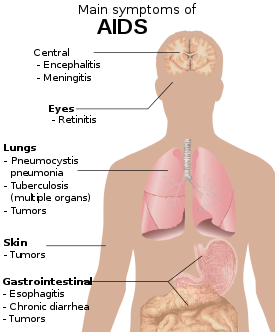 Human immunodeficiency virus infection / acquired immunodeficiency syndrome (HIV/AIDS) is a disease of the human immune system caused by infection with human immunodeficiency virus (HIV). During the initial infection, a person may experience a brief period of influenza-like illness. This is typically followed by a prolonged period without symptoms. As the illness progresses, it interferes more and more with the immune system, making the person much more likely to get infections, including opportunistic infections and tumors that do not usually affect people who have working immune systems.We can summerise HIV as following points:
Human immunodeficiency virus infection / acquired immunodeficiency syndrome (HIV/AIDS) is a disease of the human immune system caused by infection with human immunodeficiency virus (HIV). During the initial infection, a person may experience a brief period of influenza-like illness. This is typically followed by a prolonged period without symptoms. As the illness progresses, it interferes more and more with the immune system, making the person much more likely to get infections, including opportunistic infections and tumors that do not usually affect people who have working immune systems.We can summerise HIV as following points: Mode Of transmission(MOT):
HIV is transmitted primarily via unprotected sexual intercourse (including anal and even oral sex), contaminated blood transfusions, hypodermic needles, and from mother to child during pregnancy, delivery, or breastfeeding.Some bodily fluids, such as saliva and tears, do not transmit HIV. we can also conclude that HIV is transmitted by three main routes: sexual contact, exposure to infected body fluids or tissues, and from mother to child during pregnancy, delivery, or breastfeeding (known as vertical transmission). There is no risk of acquiring HIV if exposed to feces, nasal secretions, saliva, sputum, sweat, tears, urine, or vomit unless these are contaminated with blood. It is possible to be co-infected by more than one strain of HIV—a condition known as HIV superinfection
programs, is a key strategy to control the spread of the disease. There is no cure or vaccine; however, antiretroviral treatment can slow the course of the disease and may lead to a near-normal life expectancy. While antiretroviral treatment reduces the risk of death and complications from the disease, these medications are expensive and may be associated with side effects.
Causative agent:
HIV belongs to a group of retroviruses called lentiviruses. The genome of retroviruses is made of RNA (ribonucleic acid), and each virus has two single chains of RNA; for replication, the virus needs a host cell, and the RNA must first be transcribed into DNA (deoxyribonucleic acid), which is done with the enzyme reverse transcriptase.
HIV infects mainly the CD4+ lymphocytes (T cells), but also to a lesser degree monocytes, macrophages, and dendritic cells (these cells are also CD4+ cells). Once infected, the cell turns into an HIV-replicating cell and loses its function in the human immune system.
Basic structure of the virus:
Basic structure of the virus:
 - The viral envelope, the outer coat of the virus, consists of two layers of lipids; different proteins are embedded in the viral envelope, forming "spikes" consisting of the outer glycoprotein (gp) 120 and the transmembrane gp41. The lipid membrane is borrowed from the host cell during the budding process (formation of new particles). gp120 is needed to attach to the host cell, and gp41 is critical for the cell fusion process.
- The viral envelope, the outer coat of the virus, consists of two layers of lipids; different proteins are embedded in the viral envelope, forming "spikes" consisting of the outer glycoprotein (gp) 120 and the transmembrane gp41. The lipid membrane is borrowed from the host cell during the budding process (formation of new particles). gp120 is needed to attach to the host cell, and gp41 is critical for the cell fusion process.
- The HIV matrix proteins (consisting of the p17 protein), lie between the envelope and core.
- The viral core, contains the viral capsule protein p24 which surrounds two single strands of HIV RNA and the enzymes needed for HIV replication, such as reverse transcriptase, protease, ribonuclease, and integrase; out of the nine virus genes, there are three, namely gag, pol and env, that contain the information needed to make structural proteins for new virus particles.

Post a Comment